

The 6 C’s of Effective Instruction. Teaching is both an art and a science, but for the inexperienced educator, it can sometimes feel like mad science.
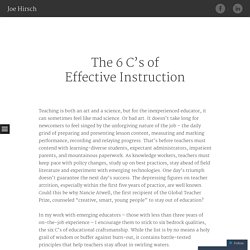
Or bad art. It doesn’t take long for newcomers to feel singed by the unforgiving nature of the job – the daily grind of preparing and presenting lesson content, measuring and marking performance, recording and relaying progress. That’s before teachers must contend with learning-diverse students, expectant administrators, impatient parents, and mountainous paperwork. As knowledge workers, teachers must keep pace with policy changes, study up on best practices, stay ahead of field literature and experiment with emerging technologies.
Educational Leadership:Teachers as Leaders:Ten Roles for Teacher Leaders. Helping leaders reach higher in 300 words or less. ABC’s for Leaders – “A” Today’s words for leaders begin with “A.”

A’s from Facebook contributors: AppreciationAllyAccessibleAffirmationAccountableAvailableAdroitAdaptiveAuthenticityAudaciousAspireAlacrity (I had to look that one up. It means: cheerful readiness. Good word.) The Bad B’s of Leadership. Bad leadership feels safe like baggy jeans and broken-in sneakers.

Bad leadership has a baffling capacity to walk comfortable paths while the world changes. Bold leadership, on the other hand, feels dangerous like learning to walk. The Great Wall of Awesome. Do school leaders take feedback from their staff? In schools, sometimes on a daily basis, there is discourse.
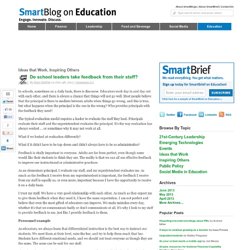
Educators work day in and day out with each other, and there is always a chance that things will not go well. Most people believe that the principal is there to mediate between adults when things go wrong, and this is true, but what happens when the principal is the one in the wrong? Who provides principals with the feedback they need? The typical evaluation model requires a leader to evaluate the staff they lead. NBCTs, show us how you embody RESPECT. Last week the U.S.

Department of Education released the Blueprint for RESPECT, a comprehensive plan for transforming and elevating the teaching profession. It incorporates the seven key elements agreed upon in the “Transforming the Teaching Profession” vision statement signed at the Department's 2012 Labor-Management Collaboration Conference, which took place in Cincinnati last March. As our CEO Ron Thorpe recently shared in a series of blog posts on building a true profession, the National Board also embraces these same principles. We know this growing consensus at the national level reflects large and small efforts underway in states and districts all across the country, where NBCTs are leading the way. Why Complex Teacher Evaluations Don't Work.
Teacher Evaluation: What's Fair? What's Effective?:The Two Purposes of Teacher Evaluation. November 2012 | Volume 70 | Number 3 Teacher Evaluation: What's Fair?
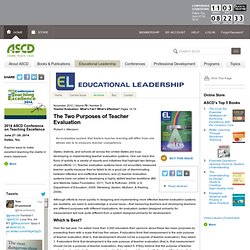
What's Effective? Pages 14-19 Robert J. Marzano States, districts, and schools all across the United States are busy developing or implementing teacher evaluation systems. Although efforts to move quickly in designing and implementing more effective teacher evaluation systems are laudable, we need to acknowledge a crucial issue—that measuring teachers and developing teachers are different purposes with different implications. Coaching to increase teacher effectiveness. The Lasting Impact of Instructional Coaching.

Response: Ways To Observe Teachers Without Demoralizing Them - Classroom Q&A With Larry Ferlazzo. What should teacher walk-throughs measure? SmartBlogs. Teacher walk-throughs are formative data collection opportunities for teachers and leaders to learn about general trends in a school.
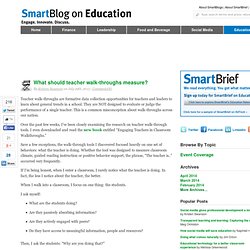
They are NOT designed to evaluate or judge the performance of a single teacher. For 'Connected Educator Month,' Tips From 33 Educators We Admire. Stacy BrownErin Olson, an English teacher in Iowa who is featured in our post, uses Twitter-like technology to enhance classroom discussion.
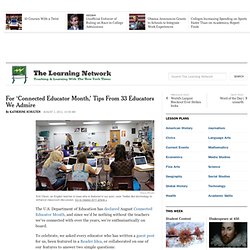
Go to related 2011 article » The U.S. Department of Education has declared August Connected Educator Month, and since we’d be nothing without the teachers we’ve connected with over the years, we’re enthusiastically on board. To celebrate, we asked every educator who has written a guest post for us, been featured in a Reader Idea, or collaborated on one of our features to answer two simple questions: What is one important thing you’ve learned from someone in your Personal Learning Network (P.L.N.), however you define that network? National Board for Professional Teaching Standards: National Board for Professional Teaching Standards. National Board Makes Real Reform - John Wilson Unleashed. It is no secret that I think the National Board for Professional Teaching Standards(NBPTS) is the best hope for building and sustaining a true teaching profession for the United States of America.
Modern curation: How does it change teaching? SmartBlogs. “The self is not something ready-made, but something in continuous formation through choice of action.” — John Dewey Rewind: The old way of curation In the past, curating resources was relatively easy.
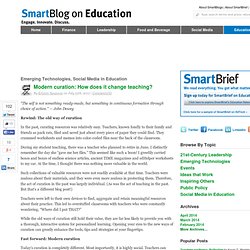
Teachers, known fondly to their family and friends as pack rats, filed and saved just about every piece of paper they could find. They crammed worksheets and memos into color-coded files near the back of the classroom. During my student teaching, there was a teacher who planned to retire in June. Such collections of valuable resources were not readily available at that time. Teachers were left to their own devices to find, aggregate and retain meaningful resources about their practice. Teacher Leader Model Standards.